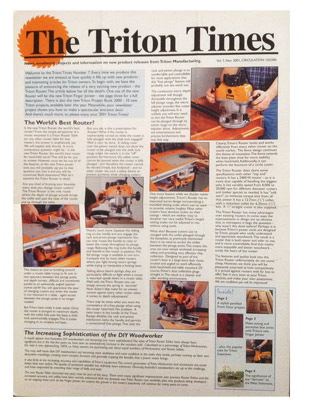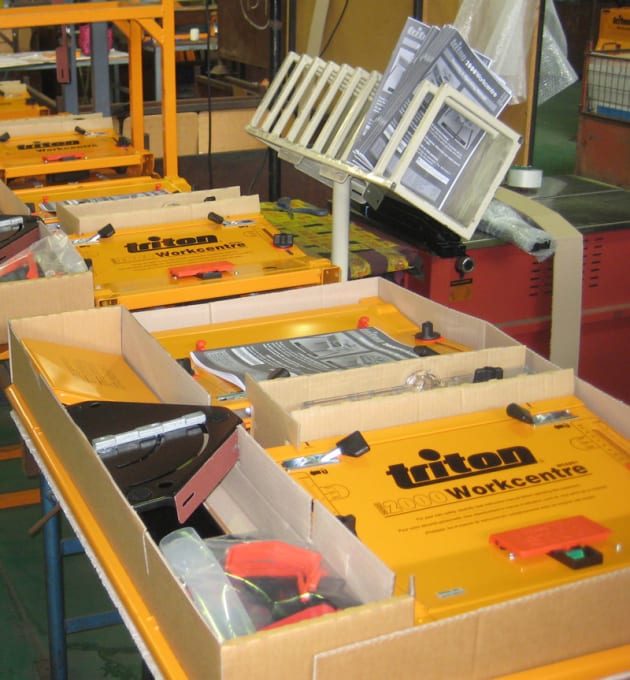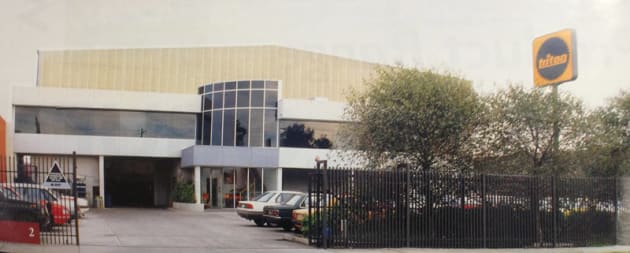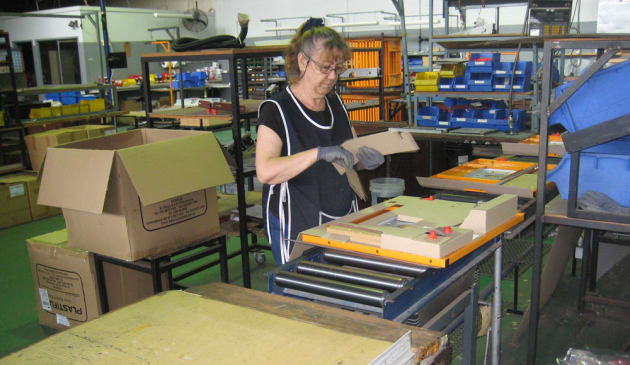The Triton Revolution
Founded by George Lewin in 1975, Triton is one of those brands that are etched into the Australian psyche as very much a native species, despite the fact that its ownership went offshore.
Triton Manufacturing and Design Co, as it was originally called, unleashed a revolution for individual makers, in particular part-time and hobbyist woodworkers.
With their versatile workcentre, Triton offered a one-stop sawing, clamping device that would become the creative heart of over 400,000 sheds locally and the world over and launched many on their woodworking journey.
With its distinctive orange livery the Triton range came to include other workstations and accessories, and later on a range of power tools and benchtop machines. In particular the Triton router (TRA001) released in 2001 sparked another revolution with its power and above tabletop bit changing capability.
Way back in time, the old Triton head office.
A big part of Triton’s success, according to Gordon Heggie, Triton employee for over 30 years and a former sales manager, demonstrator and trainer, was that ‘Triton was perfect for its time because it landed in an Australian market where DIY was on the rise, more so than in any other country.
Australians were unique in that they tended to buy bigger power tools that they were often then afraid to use. Triton “tied” those powerful tools down to a work or router bench and offered them safe precision machining.’
Triton’s founder George Lewin not only became known for his innovative designs, but for encouraging innovation from other designers. How did it all get started? An explanation recently emerged on Stuart Lees’s popular online blog*, penned by George himself. ‘It had been nurtured from an idea that took root in my head one fine day when I was a 25 year-old TV journalist for ABC-TV News, struggling to build a dining table.
With incredible twists and turns and with the help of some wonderful people, that idea grew into a multi-award winning business that ended up employing hundreds of people, and which sold about $300 million worth of products around the world over the ensuing 25 years.’
In the same post George goes on to explain how his decision to sell Triton in the mid-90s was a personal one where he wanted to reaffirm his own identity and address his ‘chronic workaholism’. Triton’s success as an innovator had brought it onto the radar of large manufacturers such as Black & Decker who sought to add to their topline Elu range and market the workcentre throughout Europe.
An offer came from UK-based Global Machinery Corporation (GMC) but was refused. Eventually In 1999, George sold the company to an Australian company, Adelaide based Hills Industries. Under Hills, Triton’s profitability and market share went down and ironically it was then sold offshore to GMC.
After GMC went into receivership Triton was bought out in 2009 by UK-based Powerbox. After that things were back on the up, flash forwarding to April, 2014 where distribution rights were given over to White International who have rebuilt the brand and expanded distribution.
George Lewin went on to develop the Triton Foundation, a not-for- profit which sought to encourage and mentor inventors. Interestingly, the Triton Foundation was instrumental in bringing The New Inventors onto ABC TV, a show whose forerunner, The Inventors, gave him his first break.
From the start, innovative marketing drove sales of innovative products. Triton installed video players and TVs in 250 stores around Australia screening product presentations mostly by George Lewin himself. Triton instigated live in-store events with a team of 55 demonstrators who were sought-after by other companies for their sales skills, because, as Gordon Heggie said, ‘we used to say we hopped over the counter and dealt directly with the people who were buying’.
 ‘Where other companies allocated around 5% of their budget to marketing, Triton spent 14–15%’, Gordon said. Once a year, in October, The Triton Times, a full colour tabloid size broadsheet, was mailed out to a list of 60,000. New products, projects, profiles, discount tickets to wood shows and other info made for a well-read publication.
‘Where other companies allocated around 5% of their budget to marketing, Triton spent 14–15%’, Gordon said. Once a year, in October, The Triton Times, a full colour tabloid size broadsheet, was mailed out to a list of 60,000. New products, projects, profiles, discount tickets to wood shows and other info made for a well-read publication.
Knowing they would sell off the back of this mail-out, Triton reps would approach retailers in August and September and convince them they needed to get their orders in! With low margins, reps were also furnished with statistics harvested from buyer warranty card surveys that showed retailers why selling Triton goods would generate a further $3000 sales of related products within 12 months and potentially much more in the long term.
With its face-to-face marketing and retailing initiatives, Triton created a culture of ownership which led to the establishment of Triton Owners Clubs. At one stage there were around 25 clubs with an average of 40–50 members. ‘The Triton Owners Clubs had the effect of lifting people up to a higher level of woodworking’, said Gordon.
Sheet metal product manufacture for Triton takes place in Melbourne at Diver Consolidated Industries in Reservoir, Vic. Photo: Mark Fawthorpe
Triton’s success has relied on the innovative nature of both its products and its ability to educate and create a culture of users. Although now owned by a UK company Triton’s distributors are Australian based and production of sheet metal products such as sawbenches and router benches takes place in Melbourne, while anything with a plug or a battery is made in either China or Taiwan.
For today’s new generation of makers, the Triton brand is still a popular workshop and jobsite choice.
Triton products are distributed in Australia by White International, see www.whiteint.com.au and www.tritontools.com or phone 1300 780-876 for more information.





